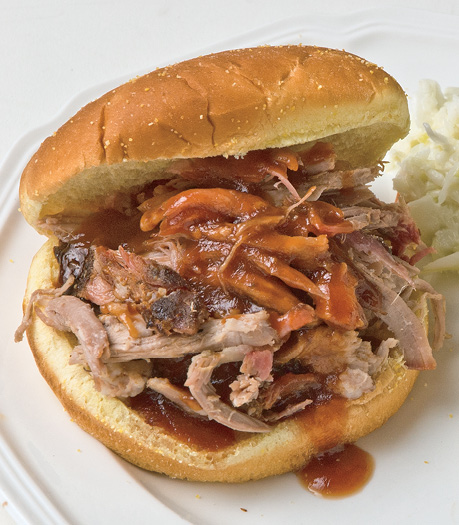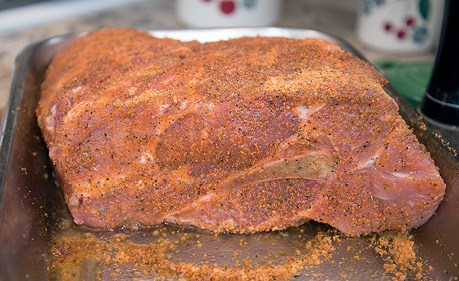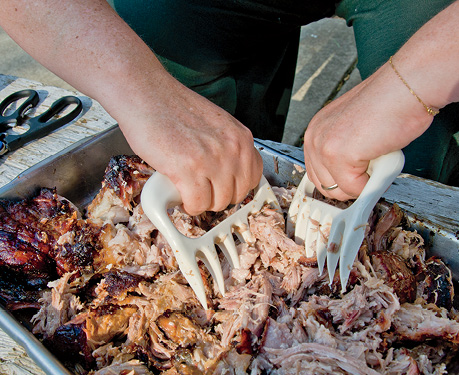Perfect Pulled Pork
With smoke woven through shards of succulent meat, potent bits of spiced bark mixed in, and a gentle splash of tangy barbecue sauce, pulled pork is the most versatile and practically foolproof low-and-slow smoked meat, perfect for feeding large crowds. It is cheap. And you can do it on practically any grill with a lid.

Pork shoulder is laced with fat and connective tissue. The cooking process, which can take 8 to 12 hours or more, is the quintessence of Southern barbecue. You set up a lawn chair and sip a cup of coffee as you put the meat on in the wee hours. As the sun gets high, you switch to cool, refreshing beer. As dusk approaches, the fat melts and the connective tissue dissolves into gelatin, your guests begin to arrive, and you switch to bourbon.
Butt Basics
How much meat will you need?
There is significant shrinkage during cooking and waste in the form of bone and globs of fat that you discard when pulling. Count on about 30 percent loss—if there is less, you’ll have leftovers. I usually buy 1 pound per person and look forward to leftovers. It freezes beautifully.
Skip the Marinade, Injections, and Brines
Some folks like to inject butt with an internal marinade. If you are in a competition, you should consider injections to get an edge, but the improvement is small. When I’m cooking at home, I don’t bother. Dry brining works, and if you can get salt on a day in advance, it will penetrate deep. Then use a good rub, and let the smoke flavor it and the internal fat and collagen moisturize it.
Cooking Time
The determining factor in cooking time for all meats is its thickness, so smaller butts will cook faster because they are skinnier. Surprisingly, if you are cooking a whole shoulder with the butt and the picnic combined, it will not take much longer than a butt alone, since the added weight isn’t thickness but length.
The meat is at its maximum tenderness and juiciness when it hits about 203°F. If the roast is not ready on time, don’t panic. You can crank up the heat if you are running behind. Butt can handle it. The bark might get a bit dry and there might be a little more shrinkage than usual, but it will still be delicious. If you kick the temperature up to about 275°F, you can cut the cooking time by 2 to 4 hours.
If it is time to serve and the butt is still not at the ideal internal temperature, just slice the meat. Don’t pull it because it won’t shred easily. Slices of smoked pork butt are wonderful.
Makes 3 pounds pork, enough for 8 to 12 generous sandwiches
Takes 25 minutes to trim and salt the meat; 12 to 24 hours to let the salt penetrate (optional; see Butt Basics, page 200); 8 to 12 hours cooking time at 225°F; 20 minutes pulling time, if you do it with your fingers (ouch!), 10 minutes with Bear Paws (see page 109)
- 1 pork butt (about 5 pounds)
- ½ teaspoon kosher salt per pound of meat (2½ teaspoons for 5 pounds)
- ⅓ cup Meathead’s Memphis Dust (page 167)
- 12 kaiser rolls or hamburger buns
- 1 cup barbecue sauce (use your favorite—I’m partial to South Carolina Mustard sauces like the one on page 177)
1. Prep. The day before serving, trim all but ⅛ inch of the fat from the exterior of the meat. If it has flaps hanging out, you might need to tie it with butcher’s twine. Don’t worry if it doesn’t look fancy. Rinse the meat to remove any bone shards from butchering. Dry it and salt it, using ½ teaspoon per pound of meat. It’s best to let it rest in the fridge overnight.
2. Just before cooking, lightly moisten all surfaces of the meat with water. This will help the rub adhere and also help it dissolve to aid bark formation. Now cover your butt (ahem) generously with Meathead’s Memphis Dust.

3. Insert a leave-in digital meat thermometer if you have one, positioning the tip right in the center of the meat. Make sure it is not within 1 inch of the bone.
4. Fire up. Get your smoker up to 225°F or set up the grill for two-zone cooking and shoot for about 225°F on the indirect side.
5. Cook. Put the meat right on the grate, not in a pan. Put about 4 ounces of wood on the fire and make your sauce, slaw, and beans. Watch the game. Then cut the lawn. Wash the windows. Read a book. You’ve got plenty of time.
Check the cooker every hour or so to make sure the fuel is sufficient and the temperature is holding at 225 to 250°F. This cut is forgiving, so if it goes up to 300°F, don’t worry, but try to keep it under 250°F. Add about 4 ounces fresh wood every 30 minutes for the first 2 hours for a total of 1 pound. No need to add more.
When the meat hits about 150°F, you can expect the stall (see page 59). The exact temperature will depend on a number of variables, but if you are cooking under 300°F, the meat will stall. During cooking, moisture is constantly evaporating from the surface of the meat, and it cools the meat like sweat on a marathon runner. The cooling effect of the evaporation just about equals the heating of the meat.
Now you have a choice. You can let it take its time. The surface will dry out, making your bark, and when the pork reaches about 170°F, collagens, which are part of the connective tissues, begin to melt and turn to gelatin. That’s magic, baby. The meat gets much more tender and juicy when this happens. Or you can power through the stall by tightly wrapping the meat in foil, a process called the Texas crutch (see page 60), so moisture cannot evaporate and cool the meat. This can cut as much as 4 hours off your cooking time. The meat will be just as moist and tender but the crutch will make the bark softer. Your choice. Me? I rarely crutch.
When it hits 195°F, it may be ready, but I recommend you wait until the pork hits 203°F. If there is a bone (see page 200), use a glove or paper towel to protect your fingers and wiggle it. It should be loose enough to pull out. The exterior should be dark brown. Some rubs and cookers will make the meat look black like a meteorite, but it is not burned and it won’t taste burned. There may be glistening bits of melted fat on the surface. On a gas cooker, it may look shiny pink. Don’t add sauce while it is on the cooker. That comes after you pull it.

6. When the pork is finally ready, go ahead and take a taste. You should notice a thick, flavorful crust with the telltale smoke ring directly beneath it.
7. If you are more than an hour from mealtime, you can leave the meat on the cooker with the heat off or put it in the indoor oven at about about 170°F and hold it there. If you are more than 2 hours from mealtime, wrap it in foil to keep it from drying out and hold it at 170°F. If you are taking the meat to a party, wrap it in foil and put it in a faux Cambro (see page 50).

At right, the bone has been removed from the butt after cooking. The elbow joint is at the top, the humerus is in the center, and the shoulder blade is in the foreground. If the meat is properly cooked, this bone should pull out easily with two fingers and have almost no meat stuck to it, just like this one.
8. About 30 minutes before sitting down for dinner, put the meat in a large pan to catch the drippings. Now pull the clod apart with Bear Paws (see below) or use gloved hands or forks. If you wish, you can slice it or chop it like they do in North Carolina, but I think you lose less moisture when pulling it apart by hand since the meat separates into bundles of muscle fibers, which is why it is called pulled pork. Discard any big chunks of fat. Try not to eat all the flavorful crusty bits when you are doing the pulling, and instead distribute them evenly throughout. Make sure you save any flavorful drippings.

9. Serve. The classic pulled pork sammich is my favorite way to serve it. Mound it high on a nice bun. Top it with a small amount of your favorite sauce. KC Classic (page 175) sweet red sauce is always popular, but pulled pork is where the East Carolina Mop Sauce (page 178) really shines. Or try Lexington Dip (page 179). I also love the mustard sauces like Columbia Gold (page 177).
I like my pulled pork with chopped raw onion mixed in. My wife likes hers with grilled onion on top. Sometimes we chop up raw apple and mix it in, too. Occasionally I slice the roast rather than pull it and douse it with a classic Texas sauce (page 179), which is thin and more like a gravy. It lets the meat flavor come through without masking it. I know folks who like to garnish pulled pork with sliced tomato, pickle chips, and a raw onion slice. In South Carolina and other places in the South, people like to mound it on a bun with slaw (use my Classic Deli Slaw, page 364).
For big parties away from home, I smoke 3 or more butts, pull them, and then put them in a big pan. I add about ½ cup sauce per 5 pounds meat, and about 1 tablespoon butter per pound to keep it moist. I carry it to the party in a faux Cambro (see page 50). When I get to the party, I heat it in a slow cooker and serve the sauce on the side.